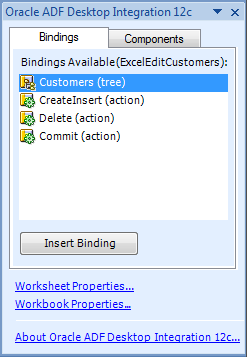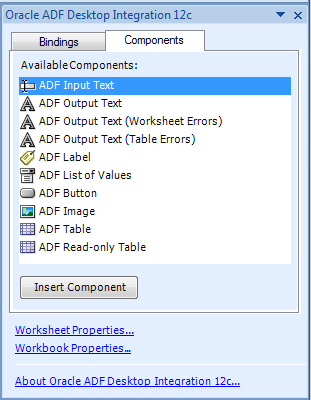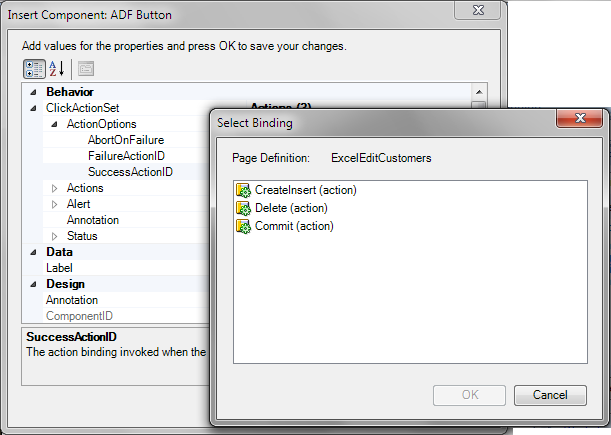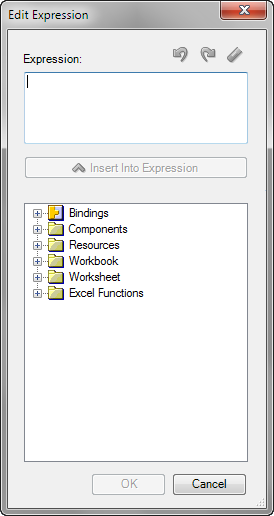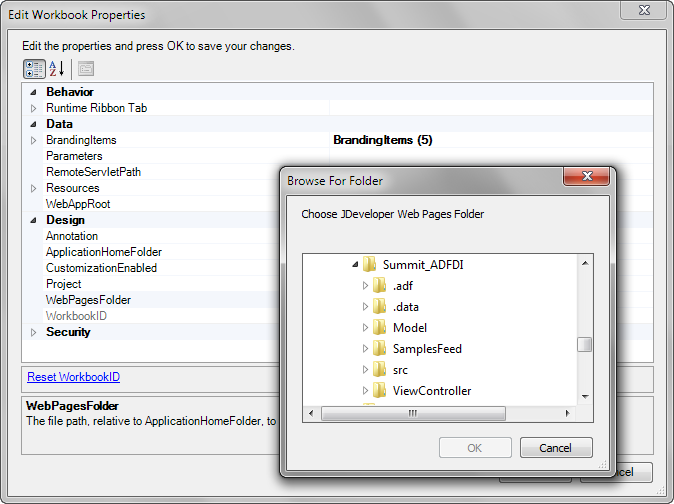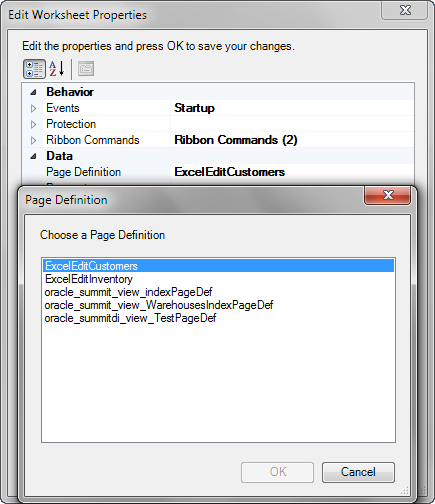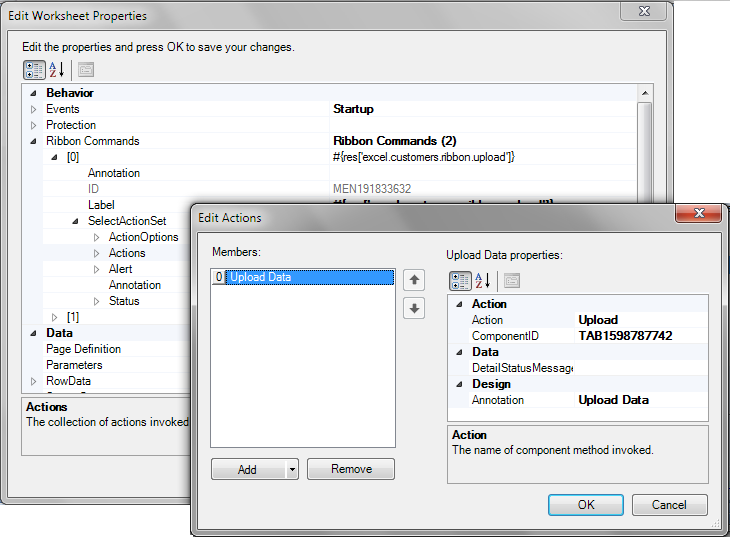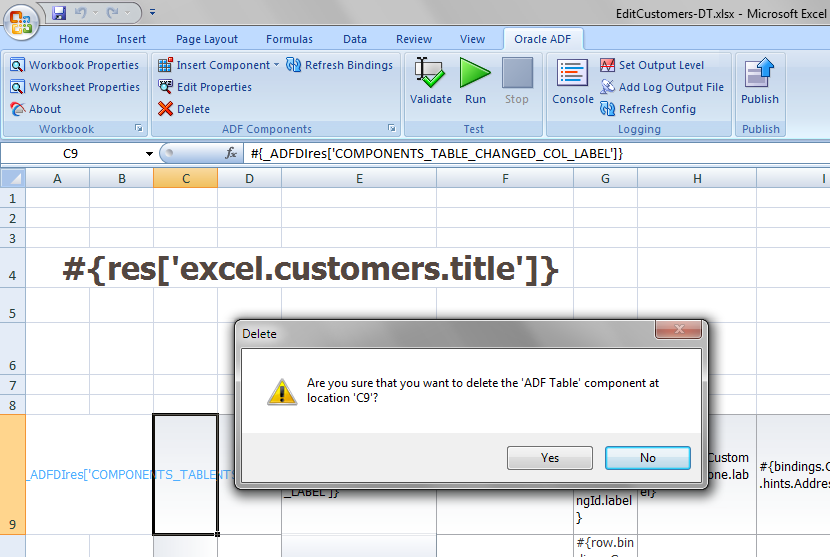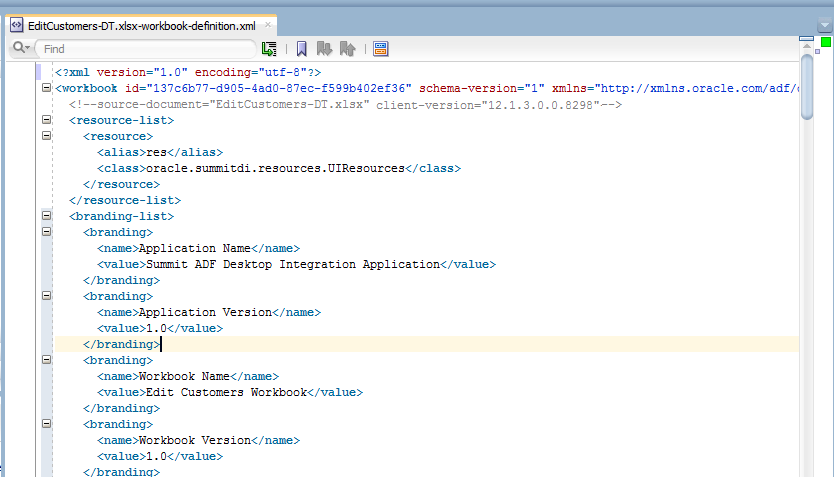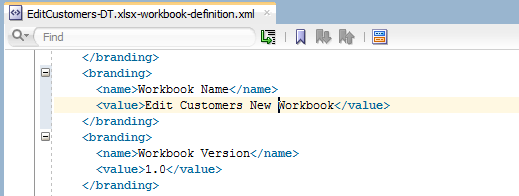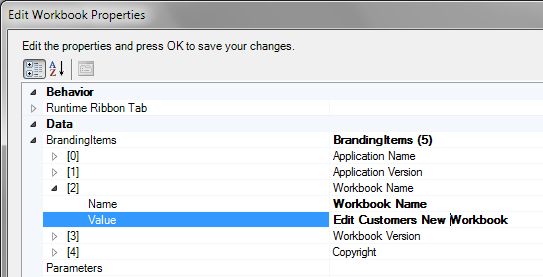5 Getting Started with the Development Tools
This chapter describes how to use the development tools (such as Bindings Palette, Components Palette, Property Inspector, and Expression Builder) provided by ADF Desktop Integration. It provides an overview of the development environment that ADF Desktop Integration exposes in the Excel Ribbon.
This chapter includes the following sections:
5.1 About Development Tools
ADF Desktop Integration provides several tools to configure Excel workbooks so that they can access Oracle ADF functionality. Using these tools you configure the workbook and corresponding worksheets to display, and edit, data from the Fusion web application in the integrated Excel workbook. The tools are available in the Oracle ADF tab and in the ADF Desktop Integration Designer task pane.
ADF Desktop Integration development tools include the following tools, also shown in Figure 5-1:
-
Bindings Palette
-
Components Palette
-
Property Inspector
-
Binding ID Picker
-
Expression Builder
-
Web Page Picker
-
File System Folder Picker
-
Page Definition Picker
-
Collection Editors
ADF Desktop Integration provides two modes, design mode and the test mode, in which you can work while you configure the Excel workbook.
In design mode, you use the tools provided by Oracle ADF in Excel to design and configure the integrated Excel workbook. In test mode, you can view and test the changes you made in the design mode, in the same way that the end user views the published integrated Excel workbook.
5.1.1 ADF Desktop Integration Development Tools Use Cases and Examples
You use the development tools to configure and design the integrated Excel workbook. For example, as shown in Figure 5-2, in EditCustomers-DT.xlsx a binded ADF Table component is inserted in the integrated Excel workbook using the Customers binding from the Bindings palette.
Other ADF Desktop Integration components, such as ADF Button and ADF Label, are inserted from the Components palette, and configured using the Property Inspector and Expression Builder.
5.1.2 Additional Functionality for ADF Desktop Integration Development Tools
After adding the desired components and configuring your work, you may find that you need additional functionality such as changing the appearance of the workbook, and localizing it. Following are links to other functionality that you can use:
-
Localization: You can customize the integrated Excel workbook as part of the process to internationalize and localize with the Fusion web application. For more information, see Chapter 10, "Internationalizing Your Integrated Excel Workbook."
-
Styles: You can configure the display of your components using several predefined Excel styles. For more information, see Section 9.2, "Working with Styles."
-
EL Expressions: You can use EL expressions with the ADF Desktop Integration components. For more information, see Appendix B, "ADF Desktop Integration EL Expressions."
5.2 Designer Ribbon Tab
You use the Oracle ADF tab, also called as Designer Ribbon tab, for various tasks such as configuring the integrated workbook and worksheets properties, insert Oracle ADF components and edit their properties, run the workbook in test mode, and publish the workbook. The Oracle ADF tab, also shown in Figure 5-3, provides various buttons in design mode.
Tip:
To access Oracle ADF tab from the keyboard, press Alt+C. Press the Alt key again to view the shortcut keys for Oracle ADF tab command buttons.
You can use Oracle ADF tab buttons to invoke the actions described in Table 5-1.
Table 5-1 Oracle ADF Tab Options
| In this group... | Click this button... | To... | Mode when the button is available... |
|---|---|---|---|
|
Workbook |
Display the Edit Workbook Properties dialog to view and edit integrated Excel workbook properties. The button is also used to enable ADF Desktop Integration in a non-integrated Excel workbook. |
Design |
|
|
Workbook |
Display the Edit Worksheet Properties dialog to view and edit the current worksheet properties. |
Design |
|
|
Workbook |
Open the About ADF Desktop Integration dialog that provides version and property information of integrated Excel workbook. The button is also available in non-integrated Excel workbooks after ADF Desktop Integration is installed. |
Design, Test |
|
|
Workbook |
Open the Save Workbook Definition as dialog that exports the current workbook definition as |
Design |
|
|
Workbook |
Open the Choose Workbook Definition File to Import dialog that imports the workbook integration metadata from the saved |
Design |
|
|
ADF Components |
Display a dropdown list of Oracle ADF components that you can insert in the selected cell. |
Design |
|
|
ADF Components |
Display the property inspector window to view and edit component properties of the selected component. |
Design |
|
|
ADF Components |
Delete the selected component from the Excel worksheet. |
Design |
|
|
ADF Components |
Any modifications that you made to the page definition files in the JDeveloper project now become available in the Excel workbook. For more information, see Section 4.3.3, "How to Reload a Page Definition File in an Excel Workbook." |
Design |
|
|
Test |
 |
Validate the Excel workbook configuration against ADF Desktop Integration validation rules. For more information about validating a workbook, see Section 13.3, "Validating the Integrated Excel Workbook Configuration." |
Design |
|
Test |
Switch the Excel workbook from design mode to test mode. This button is active only when you are in design mode. |
Design |
|
|
Test |
Switch the Excel workbook from test mode to design mode. This button is active only when you are in test mode. For more information about switching between design mode and test mode, see Section 13.4, "Testing Your Integrated Excel Workbook." |
Test |
|
|
Logging |
Display a dialog to review the client-side log entries. For more information, see Section C.3.2, "About Client-Side Logging." |
Design, Test |
|
|
Logging |
Display the Set Output Level dialog to choose client-side log output level. For more information, see Section C.3.2, "About Client-Side Logging." |
Design, Test |
|
|
Logging |
Create a new temporary logging listener to act as a client-side log output file. For more information, see Section C.3.2, "About Client-Side Logging." |
Design, Test |
|
|
Logging |
Reload the ADF Desktop Integration configuration file. For more information, see Section C.3.2, "About Client-Side Logging." |
Design, Test |
|
|
Publish |
Publish the Excel workbook after you complete the integration between the Excel workbook and the Fusion web application. For more information about publishing an integrated Excel workbook, see Chapter 14, "Deploying Your Integrated Excel Workbook." |
Design |
Tip:
For quick and easy access, you can add Oracle ADF tab buttons to the Excel Quick Access toolbar.
5.3 ADF Desktop Integration Designer Task Pane
The development tools in ADF Desktop Integration Designer Task Pane are organized in two palettes, the Bindings palette and the Component palette. You use the Bindings palette of ADF Desktop Integration Designer task pane to insert a predefined binding into the integrated Excel workbook. ADF Desktop Integration inserts an Oracle ADF component that references the binding you selected, and prepopulates the properties of the Oracle ADF component with appropriate values. Similarly, you use the Components palette to insert an Oracle ADF component in the integrated Excel workbook. Figure 5-4 displays the ADF Desktop Integration Designer task pane.
You invoke the ADF Desktop Integration Designer task pane through launcher buttons (highlighted by the red boxes in Figure 5-5) available in the bottom-right corner of the Workbook and ADF Components group on the Oracle ADF tab.
Table 5-2 lists the view tabs and links that appear in the task pane, provides a brief description of each item.
Table 5-2 Overview of ADF Desktop Integration Designer Task Pane
| Task Pane UI Element | Description |
|---|---|
|
Workbook Properties |
Click to display the Edit Workbook Properties dialog. This dialog enables you to view and edit properties that affect the whole workbook. Examples include properties that reference the directory paths to page definition files, the URL for your Fusion web application, and so on. |
|
Worksheet Properties |
Click to display the Edit Worksheet Properties dialog. This dialog enables you to view and edit properties specific to the active worksheet. An example is the file name of the page definition file that you associate with the worksheet. |
|
About |
Click to display the About dialog. This dialog provides the version and property information that can be useful when troubleshooting an integrated Excel workbook. For example, it provides information about the underlying Microsoft .NET and Oracle ADF frameworks that support an integrated Excel workbook. |
5.4 Using the Bindings Palette
The bindings palette presents the available Oracle ADF bindings that you can insert into the Excel worksheet. The page definition file for the current Excel worksheet determines what Oracle ADF bindings appear in the bindings palette. Figure 5-6 shows a bindings palette populated with Oracle ADF bindings in the ADF Desktop Integration Designer task pane. Note that the bindings palette does not display bindings that an integrated Excel workbook cannot use, so the bindings that appear may differ from those that appear in the page definition file viewed in JDeveloper. Check the log for ignored bindings (see Section C.3, "Generating Log Files for an Integrated Excel Workbook").
You use the bindings palette in design mode to insert a binding. When you attempt to insert a binding, ADF Desktop Integration inserts an Oracle ADF component that references the binding you selected. ADF Desktop Integration also prepopulates the properties of the Oracle ADF component with appropriate values. For example, if you insert a binding, such as the Commit (action) binding illustrated in Figure 5-6, the property inspector for an Oracle ADF Button component appears. This Oracle ADF Button component has values specified for its ClickActionSet that include invoking the Commit action binding.
To insert an Oracle ADF binding, select the cell to anchor the Oracle ADF component that is going to reference the binding in the Excel worksheet, and then insert the binding in one of the following ways:
-
Double-click the Oracle ADF control binding you want to insert.
-
Select the binding that you want to insert, and drag it to the desired cell.
-
Select the control binding and click Insert Binding in the ADF Desktop Integration Designer task pane.
A property inspector for the Oracle ADF component that is associated with the binding you attempt to insert appears. In some instances, you may be prompted to select one Oracle ADF component from a list of Oracle ADF components where multiple Oracle ADF components can be associated with the binding. After you select an Oracle ADF component from the list, a property inspector appears.
If you choose the Oracle ADF component as ADF Input Text, ADF Output Text, or ADF Label, the binding name is assigned to the Value property. If you choose the Oracle ADF component as ADF Button or ADF Ribbon Command, the binding name is assigned to the Label property. If you choose the Oracle ADF component as ADF Table or ADF Read-only Table, the binding name is assigned to the TreeID property.
5.5 Using the Components Palette
The components palette displays the available ADF Desktop Integration components that you can insert into an Excel worksheet. Figure 5-7 shows the components palette as it appears in the ADF Desktop Integration Designer task pane.
You use the components palette in design mode to insert an Oracle ADF component. First, select the cell to anchor the Oracle ADF component in the Excel worksheet, and then insert the Oracle ADF component in one of the following ways:
-
Double-click the Oracle ADF component you want to insert.
-
Select the component that you want to insert, and drag it to the desired cell.
-
Select the component and click Insert Component in the ADF Desktop Integration Designer task pane.
In all of the above cases, the Oracle ADF component's property inspector appears. Use the property inspector to specify values for the component before you complete its insertion into the Excel worksheet.
Note:
The ADF Desktop Integration components are also available in the Insert Component dropdown list of Oracle ADF tab.
5.6 Using the Property Inspector
The property inspector is a dialog that enables you to view and edit the properties of Oracle ADF bindings, Oracle ADF components, Excel worksheets, or the Excel workbook. You can open the property inspector in one of the following ways:
-
Select the component or binding, and click the Edit Properties icon in the Oracle ADF tab.
-
Select the component or binding, right-click and choose Edit ADF Component Properties.
-
Double-click the component or binding.
To open property inspector of ADF Table or ADF Read-only Table, double-click any cell that is part of the table.
Note:
ADF Button does not support the right-click or double-click action, click the button to open the property inspector dialog.
The property inspector also appears automatically after you insert an Oracle ADF binding or component into an Excel worksheet. Figure 5-8 shows a property inspector where you can view and edit the properties of an Oracle ADF Button component.
At design time, you can edit key properties of certain Oracle ADF components by editing the Excel cell where the component appears. For example, you can edit the Value property of ADF Label and ADF Input Text components by editing the value displayed in the cell.
Note:
The property inspector does not validate the values you enter for a property, or combinations of properties. Invalid values may cause runtime errors. To avoid runtime errors, make sure you specify valid values for properties in the property inspector.
You can display the properties in an alphabetical list or in a list where the properties are grouped by categories such as Behavior, Data, and so on. Table 5-3 describes the buttons that you can use to change how properties display in the property inspector.
Table 5-3 Buttons to Configure Properties Display in Property Inspector
| Button | Description |
|---|---|
|
Use this button to display the properties according to category. |
|
|
Use this button to display the properties in an alphabetical list. |
In Figure 5-8, the property inspector displays the properties grouped by category.
5.7 Using the Binding ID Picker
The binding ID picker is a dialog that enables you to select Oracle ADF bindings at design time to configure the behavior of Oracle ADF components at runtime. You invoke the binding ID picker from the property inspector. The binding ID picker filters the Oracle ADF bindings that appear, based on the type of binding that the Oracle ADF component property accepts. For example, the SuccessActionID property for an ADF Button component supports only action bindings. Therefore, the binding ID picker filters the bindings from the page definition file so that only action bindings appear, as illustrated in Figure 5-9.
For more information about ADF Desktop Integration component properties and the bindings they support, see Appendix A, "ADF Desktop Integration Component Properties and Actions."
5.8 Using the Expression Builder
You use the expression builder to write Expression Language, or EL, expressions that configure the behavior of components at runtime in the Excel workbook. You invoke the expression builder from the property inspector of component properties that support EL expressions. For example, the Label property in Figure 5-10 supports EL expressions and, as a result, you can invoke the expression builder to set a value for this property.
You can reference bindings in the EL expressions that you write. Note that the expression builder does not filter bindings. It displays all bindings that the page definition file exposes. See Table 4-1 to identify the types of bindings that each ADF Desktop Integration component supports.
To add an expression in the Expression box, select the item and click Insert Into Expression. You can also double-click the item to add it in the Expression box. Table 5-4 describes the folders available in the expression builder.
Table 5-4 Expression Builder Folders
| Folder Name | Description |
|---|---|
|
Bindings |
Lists the bindings supported in ADF Desktop Integration from the current worksheet's page definition. |
|
Components |
Lists the ADF components available in the current worksheet. |
|
Resources |
Lists the resource bundles registered in |
|
Styles |
Lists all Excel styles defined in the current workbook. For more information, see Section 9.2, "Working with Styles.". |
|
Workbook |
Lists parameters defined in |
|
Worksheet |
Lists the |
|
Excel Functions |
Lists sample Excel functions that you can use with ADF Desktop Integration. For more information, see Excel's documentation. |
For more information about using the expression builder, see Section 9.3, "Applying Styles Dynamically Using EL Expressions." For information about the syntax of EL expressions in ADF Desktop Integration, and guidelines on how you write these expressions, see Appendix B, "ADF Desktop Integration EL Expressions."
5.9 Using the Web Page Picker
Use the web page picker to select a web page from your Fusion web application. At runtime, an Oracle ADF component, for example an Oracle ADF Button component, can invoke the web page that you associate with the Oracle ADF component.
You can invoke the web page picker when you add a Dialog action to an action set in the Action Collector Editor. You use the web page picker to specify a web page for the Page property of the Dialog action, as illustrated in Figure 5-11.
For more information about displaying web pages in your integrated Excel workbook, see Section 8.4, "Displaying Web Pages from a Fusion Web Application."
5.10 Using the File System Folder Picker
Use the file system folder picker to navigate over the Windows file system and select folders. You use this picker to specify values for the following workbook properties:
-
ApplicationHomeFolder -
WebPagesFolder
The first time you open an Excel workbook the picker appears so that you can set values for the previously listed properties. For more information about opening an Excel workbook for the first time and the properties you set, see Section 4.2.2, "How to Configure a New Integrated Excel Workbook."
Figure 5-12 shows the file system folder picker selecting a value for the ApplicationHomeFolder workbook property.
5.11 Using the Page Definition Picker
Use the page definition picker to select the page definition ID of a page definition file and associate the file with a worksheet. The picker appears the first time that you activate a worksheet in an integrated Excel workbook. It can also be invoked when you attempt to set a value for the worksheet property, PageDefinition, as illustrated in Figure 5-13.
For more information about page definition files, see Section 4.3, "Working with Page Definition Files for an Integrated Excel Workbook."
5.12 Using the Collection Editors
ADF Desktop Integration uses collection editors to manage the properties of elements in a collection. The title that appears in a collection editor's title bar describes what the collection editor enables you to configure. Examples of titles for collection editors include Edit CachedAttributes, Edit Columns, and the Edit Actions. These collection editors allow you to configure collections of cached data, table columns in the ADF Table component, and actions in an action set. Figure 5-14 shows the collection editor.
Tip:
Write a description in the Annotation field for each element that you add to the Edit Action dialog. The description you write appears in the Members list view and, depending on the description you write, may be more meaningful than the default entry that ADF Desktop Integration generates.
5.13 Using the Cell Context Menu
When working with ADF components at design time, right-click any cell of the component to get menu options to edit or delete the component. Some keyboards feature a key that invokes the context menu. Using this key, you will see the edit and delete menu options as well. Figure 5-15 shows the context menu options of an ADF Output Text component.
You should use either the keyboard context menu key or the mouse's right-click button during any given session. If you use both the mouse right-click and the context menu key, the menu options may not always appear when expected. The context menu options do not appear if you select a range of cells and then invoke the context menu.
5.14 Removing ADF Desktop Integration Components
At design time, you can remove the inserted ADF Desktop Integration components (or bindings) from the integrated workbooks using the Delete ribbon command, or the Delete ADF Component context menu option (see Figure 5-15).
When you remove a component, ADF Desktop Integration prompts you to confirm your action, as shown in Figure 5-16.
You can also remove multiple components by selecting a range of cells anchoring the components (see Figure 5-17), or select individual component cells using the Ctrl key, and then click the Delete ribbon button.
While removing the components, make a note of the following:
-
You can also remove a single component using the Delete key of the keyboard when the component origin cell is selected.
You cannot remove a table component using the Delete key of the keyboard, use the Delete ribbon command instead.
-
To delete a component that occupies more than one cell (such as a table component, or a component in a merged cell), you need not select the entire component. If the selected range intersects any cell of the component, it will be removed.
-
Do not delete cells or clear cells of the workbook if your selection includes one or more ADF Desktop Integration components. Always use the Delete ribbon command to remove a ADF Desktop Integration component.
-
ADF Desktop Integration context menu options are not available if multiple cells are selected when the context menu is invoked.
5.15 Exporting and Importing Excel Workbook Integration Metadata
Workbook integration metadata, also known as the workbook definition, is a set of information that describes how a given workbook is integrated with a particular Fusion web application. It includes the placement and configuration of components as well as workbook- and worksheet-level properties. Workbook integration metadata is defined by Oracle ADF. It does not include settings of a workbook that are native to Excel.
You can export the integration metadata of your Excel workbook to an XML file with a name and location that you specify. The XML file contains child elements for each worksheet in the workbook, resources such as the relative path to the remote servlet, and so on. The exported XML file enables you to do the following actions:
-
Edit, or analyze the Excel workbook that is integrated with a Fusion web application.
-
Using an XML editor, copy or move components between worksheets and workbooks.
-
Copy action-set definitions between buttons or events.
-
Perform global search and replace operations.
-
Quickly rearrange, or copy, columns of table components.
5.15.1 How to Export Workbook Integration Metadata
The following procedure describes how you export XML configuration metadata from an integrated Excel workbook.
It may be helpful to have an understanding of workbook integration metadata. For more information, see Section 5.15, "Exporting and Importing Excel Workbook Integration Metadata."
To export workbook integration metadata from an integrated Excel workbook:
-
Open the integrated Excel workbook.
-
Click Export in the Oracle ADF tab.
The Save Workbook Definition As dialog box appears.
-
Specify the file name and location of the XML file that stores the exported metadata, and click Save. ADF Desktop Integration writes the workbook definition to the specified file.
-
In Export Workbook Metadata dialog, click OK to complete the export process.
Note:
The exported XML file does not contain any native Excel settings such as named styles, named ranges, cell properties, content in unbound cells, and so on. The file name comprises the full name of the design-time workbook suffixed with -workbook-defintion.xml. For example, the exported XML file name of EditCustomers-DT.xlsx is EditCustomers-DT.xlsx-workbook-definition.xml.
Publishing a workbook also exports the workbook definition. For more information about publishing a workbook, see Section 14.3, "Publishing Your Integrated Excel Workbook."
After exporting the workbook definition, you can edit the XML file in any XML editor, such as JDeveloper. Figure 5-18 shows the workbook definition of EditCustomers-DT.xlsx in JDeveloper. While editing the workbook definition file in JDeveloper, JDeveloper automatically validates your changes against the workbook definition schema. It will display warnings that help you avoid problems later on.
5.15.2 How to Import Workbook Integration Metadata
After editing, you can import the integrated metadata into an empty integrated workbook to create a copy of the source integrated Excel workbook. Note that the empty workbook must be enabled with ADF Desktop Integration before you import the metadata.
The following procedure describes how to import XML configuration metadata to an integrated Excel workbook.
It may be helpful to have an understanding of workbook integration metadata. For more information, see Section 5.15, "Exporting and Importing Excel Workbook Integration Metadata."
Before you import the integration metadata from an XML file, perform basic XML validations such as whether the XML code is well formed and the XML file contains the root element. You may import the workbook definition into the same workbook from which it was exported, or import it in a new workbook.
To import workbook integration metadata to an integrated Excel workbook:
-
Open the integrated Excel workbook.
-
Click Import in the Oracle ADF tab.
The Choose a Workbook Definition file to Import dialog box appears.
-
Select the XML file that stores the workbook integration metadata, and click Open.
-
In Import Workbook Metadata dialog, click OK to complete the import process.
The changes made in the workbook definition appear automatically in the integrated Excel workbook.
For example, Figure 5-19 shows the branding value of workbook changed to Edit Customers New Workbook in the workbook definition file.
Figure 5-20 shows the changed branding workbook value in the Edit Workbook Properties dialog after importing the workbook definition.
5.15.3 What You May Need to Know About Exporting and Importing Excel Workbook Integration Metadata
The workbook integration metadata XML file uses the adfdi-workbook-definition.xsd XML schema document, which defines the XML namespace as http://xmlns.oracle.com/adf/desktopintegration/workbook. The schema is integrated into JDeveloper through the ADF Desktop Integration add-in. You can find a copy of the schema at <MW_HOME>\jdeveloper\adfdi\etc\adfdi-workbook-definition.xsd, where MW_HOME is the Middleware Home directory.
While importing the workbook integration metadata, make a note of following points:
-
When the import process is initiated, the schema version number (
schema-versionattribute of<workbook>) of the XML file is compared against the schema version number of the installed ADF Desktop Integration client.If both values match, the workbook integration metadata is imported to the workbook. If the schema version of the XML file is lower than the schema version of the installed client, the XML file is migrated to use the installed client's schema. No prompt appears when the file is migrated, but a log of the same is maintained. If the schema version of the XML file is greater than the schema version of the installed client, the import process fails and an error message appears.
-
After verifying the schema version, the imported XML file is validated against the schema of the installed client. If the validation fails, the validation failure details are logged, an error is reported to the user, and the import process aborts. If the schema validation succeeds, the import process continues.
-
If an element is missing in the imported XML file, the default value of the element is used in the integrated Excel workbook.
-
All pre-existing worksheet and component metadata is removed before the import.
-
If the imported worksheet's name matches an existing worksheet in the integrated workbook, that worksheet is used. Otherwise, a new worksheet is created.
-
All non-integrated worksheets of the integrated Excel workbook are not affected by the import.
-
If the imported component does not have valid origin information, the import process attempts to place that component on the first unused row in the target integrated worksheet.
-
After the XML file is imported, the integrated Excel workbook's Workbook ID is replaced with the Workbook ID of the XML file. If the workbook ID is missing in the XML file, a new ID is generated.



